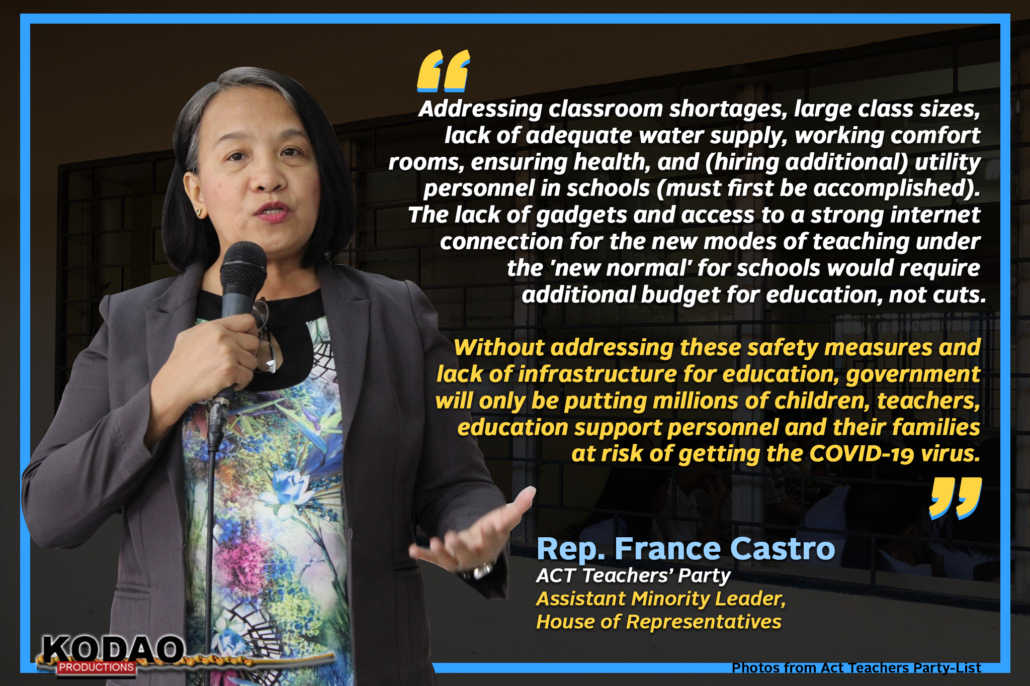Govt stinginess worsens Filipinos’ suffering and PH economic collapse
Govt stinginess worsens Filipinos’ suffering and PH economic collapse
November 10, 2020
by IBON Media & Communications
The -11.5% growth, or contraction, in gross domestic product (GDP) in the third quarter, confirms that the Philippines is on its way to becoming the worst performing economy in Southeast Asia in 2020. The economy is saddled by the Duterte administration’s refusal to spend on aid for Filipino families and support for small businesses so needed amid the pandemic.
A fiscal response commensurate to the crisis at hand is critical but the economic managers are tying the government’s hands. The government package’s demand-side effort is grossly insufficient and even undermines its supply-side measures.
The Php3 trillion in government spending in the first three quarters of 2020 is only a 15.1% increase from the same period the year before. While this is larger than the 5.5% year-on-year increase in the same period in 2019, it is still much less than the corresponding 23.6% increase in 2018.
It remains to be seen how much more spending the administration can manage in the fourth quarter of 2020. The Bayanihan 2 law is supposedly the government’s main response to COVID in the remaining months of the year.
However, as of the president’s last report to Congress at the start of November, it appears that at most just Php28.4 billion has been spent so far. With only a little over a month left in the law’s effectivity, this is just 20.3% of Bayanihan 2’s Php140 billion in appropriations and just 17.1% of its Php165.5 billion including its standby fund. The report mentioned Php76.2 billion in allotments and releases which appears relatively large.
However, the same report did not mention any actual disbursements in major items especially for aid or support to small businesses or agriculture. These items with allotments released but not reported spent include: Php6 billion for the social amelioration program (SAP); Php13.1 billion for the COVID-19 Adjustment Measures Program (CAMP), Tulong Panghanapbuhay sa Ating Disadvantaged/Displaced Workers (TUPAD) and Abot-Kamay ang Pagtulong (AKAP) programs; Php9.5 billion for public utility vehicle (PUV) programs; and Php12.1 billion for the agriculture stimulus package. While there is supposedly Php8.1 billion for small businesses, only Php893 million worth of loans were reported.
There is also little real stimulus in the proposed 2021 budget. The proposed Php4.51 trillion budget is a 9.9% increase from the 2020 budget. This is however smaller than the 13.6% increase in the programmed 2020 budget from the year before, and even smaller than the historical annual average 11.1% increase in the national budget over the 35 years of the post-Marcos era. The Development Budget Coordination Committee (DBCC) actually projects an even smaller 5.3% increase in 2022 which will be less than half the historical average.
The DBCC initially projected the economy to have -5.5% growth in 2020. To achieve this, GDP will have to grow an impossible 6.6% in the last quarter of the year which is all the more impossible with the administration refusing to give meaningful aid to millions of distressed families and small businesses including in the country’s vast informal sector.
Additional direct cash assistance to households is already pitifully small under Bayanihan 2 and virtually non-existent in the proposed 2021 budget. The record joblessness and collapse in family incomes because of the government’s poor COVID response compels much larger support to alleviate wide and deep suffering.
The economic managers also keep insisting that the CREATE law’s corporate income tax cuts will most of all benefit micro, small and medium enterprises (MSMEs). This is untrue. Large taxpayers account for an overwhelming 72% of all corporate collections as of 2019 which means that large firms will be the biggest beneficiaries of CREATE. Moreover, many MSMEs are also unregistered and in the informal sector so will not really benefit from any tax cuts under CREATE.
The International Monetary Fund (IMF) projects the economy to contract with -8.3% GDP growth in 2020. This is the worst GDP performance in the region with other countries either contracting less or even registering positive growth: Thailand (-7.1%), Malaysia (-6%), Cambodia (-2.8%), Indonesia (-1.5%), Singapore (-6%), Brunei (0.1%), Lao PDR (0.2%), Vietnam (1.6%), and Myanmar (2%).
Even the IMF’s projected 7.4% GDP growth rebound in 2021 will still not be enough to bring the economy back to its level last year in 2019. As it is, the 2020 Philippine economy is going to be as small as it was three years ago in 2017, and with GDP per capita approaching as low as it was in 2016.
The Philippines’ COVID response is the smallest among those announced by the region’s major economies, according to the Asian Development Bank’s (ADB) COVID policy tracker. This earlier reported the Philippines’ response as equivalent to just 5.8% of 2019 GDP which is smaller than in Singapore (26.2%), Malaysia (22.7%), Thailand (16%), Indonesia (10.9%), and Vietnam (10.1%).
Months into the worst economic collapse in the country’s history, the Duterte administration’s obsession with creditworthiness and the myth of a fundamentally strong Philippine economy is preventing it from taking the measures needed for real and rapid recovery. Its insensitivity is placing the burden of rebound and protracted recovery on millions of poor families and distressed small businesses. #
= = = = = =
Kodao publishes IBON articles as part of a content-sharing agreement.



